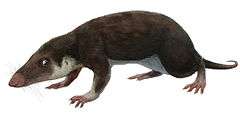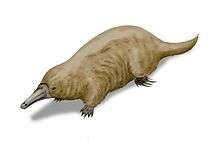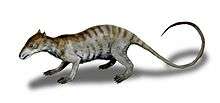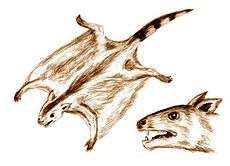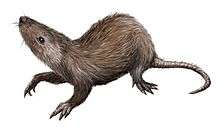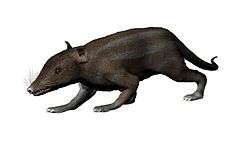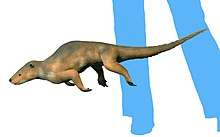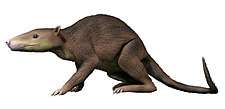Mesungulatidae
Mesungulatidae is an extinct clade of meridiolestidan dryolestoid mammals from the Late Cretaceous of South America. They are particularly notable for their ecological speciation and large size.[1]
| Mesungulatidae Temporal range: Late Cretaceous | |
|---|---|
| Scientific classification | |
| Kingdom: | |
| Phylum: | |
| Class: | |
| Subclass: | |
| Order: | |
| Family: | †Mesungulatidae Bonaparte, 1986 |
| Genera | |
| |
Characteristics
Most mesungulatids are generally large animals, making them inherently distinctive from other groups. Specific synapomorphies include a strong precingulum and postcingulum on the upper molars - which are extended lingually but do not meet around the paracone - three cusps on the lower stylar shelf, an absent metacone and rectangular lower molars.[2] They are thought to have had a somewhat transverse mastication, like docodonts and modern ungulates.[3]
Ecology
Mesungulatids are generally large sized herbivores or omnivores, being among the several Mesozoic mammals deviating from the classical insectivore stereotype. They are among the dominant mammals in Late Cretaceous South American assemblages, and among the most derived species present.[4][1]
References
- Rougier, G.W.; Forasiepi, A.M.; Hill, R.V.; Novacek, M. (2009). "New mammalian remains from the Late Cretaceous La Colonia Formation, Patagonia, Argentina". Acta Palaeontologica Polonica. 54 (2): 195–212. doi:10.4202/app.2006.0026.CS1 maint: ref=harv (link)
- Kielan-Jaworowska, Z.; Cifelli, R.; Luo, Z.-X. (2004). Mammals from the Age of Dinosaurs: Origins, Evolution, and Structure. Columbia University Press. p. 630. ISBN 978-0-231-11918-4.CS1 maint: ref=harv (link)
- Dental and Craniomandibular Anatomy of Peligrotherium Tropicalis: The Evolutionary Radiation of South American Dryolestoid Mammals, ProQuest, 2008
- Chornogubsky, L. (2011). "New remains of the dryolestoid mammal Leonardus cuspidatus from the Los Alamitos Formation (Late Cretaceous, Argentina)". Paläontologische Zeitschrift. 85 (3): 343–350. doi:10.1007/s12542-010-0095-4.CS1 maint: ref=harv (link)
